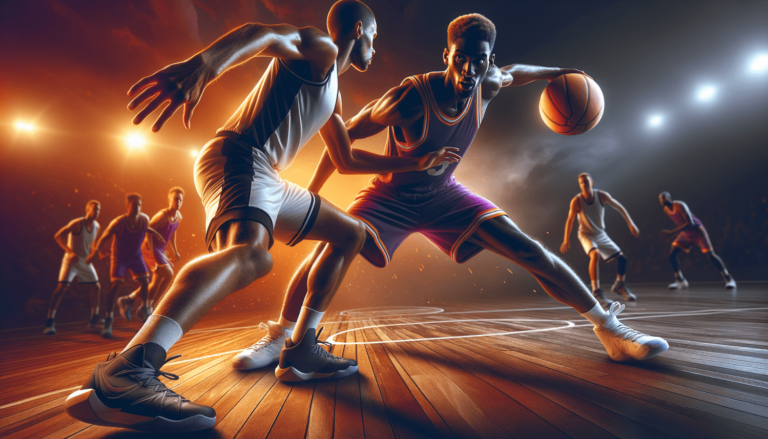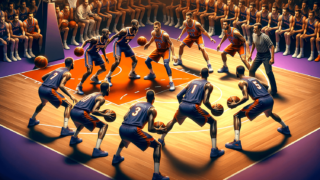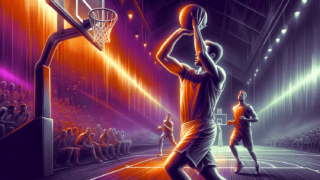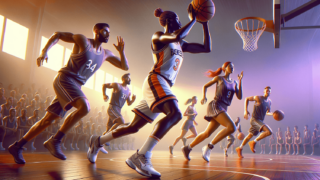
How to Become a Better Basketball Defender in the Post?
Written by: Basketball Universe
Last updated:

Excited to level up your defensive game in the post? You’re in the right place! In today’s blog post, we dive into the art and science of jockeying for position, denying entry passes, and shutting down opponents on the block. As you explore these tips, strategies, and insights, you’ll discover the secrets to becoming an impeccable post defender. Improved footwork, anticipation, and communication are just a few of the skills you’ll need to develop as we break down the fundamentals and beyond for guarding the most dominant post players. Sharpen your sneakers and brace yourself – we’re about to transform your game as a stalwart force in the paint!
How to Become a Better Basketball Defender in the Post?
To become a better basketball defender in the post, focus on improving your footwork, maintaining a strong, low stance, and learning to anticipate your opponent’s moves. Develop clear communication skills with your teammates for effective switches and double teams, practice proper positioning to deny entry passes, and use your body, arms, and hands to disrupt the offense’s flow without fouling. By consistently working on these aspects and applying them in games, you’ll enhance your post defense abilities.
Master the Art of Footwork
Footwork is the foundation of any great post defender’s arsenal. Quick, agile feet allow you to keep up with your opponent’s movements, cut off passing lanes, and recover from any missteps. Here are some key aspects to focus on when honing your footwork:
Step Slides and Drop Steps
Developing proficiency in step slides and drop steps is essential in the post. Step slides involve using your lead foot to push off and slide laterally, while your trail foot follows, always maintaining a wide, balanced stance. Practice these movements to build muscle memory and improve your agility in the post. Drop steps, on the other hand, involve pivoting off your back foot to move laterally and beat your opponent to a spot on the floor. This technique can help you deny entry passes and force the offensive player away from their ideal position.
Defensive Stance
Maintaining a low, athletic stance is crucial for an effective post defender. To do this properly, bend your knees, keep your back straight, and remain on the balls of your feet. This stance allows you to move laterally quickly while providing you with the stability needed to hold your ground against more physical opponents. Practice staying in a defensive stance and shifting laterally as you develop your footwork.
Unlock the Power of Anticipation
Being a step ahead of your opponent can be the difference between a contested shot and an open layup. The ability to anticipate your offensive player’s moves not only makes your job easier but also puts more pressure on the opposition. Let’s dive into how to unlock the power of anticipation:
Study Your Opponent
The first step in developing your anticipatory skills is understanding your opponent’s tendencies. Take the time to study their previous games, focusing on their shot selection, favorite moves, and preferred spots on the floor. By analyzing their patterns, you can be better prepared to react to their actions on the court.
Read the Offense
As a post defender, it’s important to keep an eye on the ball and understand the opposing team’s offensive patterns. By recognizing the offensive sets, you can anticipate where the ball is likely to go and position yourself accordingly. This helps you cut off any entry passes and be in an advantageous position to defend your man.
Jump to the Ball
Jump to the ball when your opponent catches an entry pass, allowing you to close the gap, deny them room to operate, and disrupt their timing. Not only does this make it harder for the offensive player to score, but it also increases the likelihood of deflections and steals.
Embrace Physicality
Basketball, particularly in the post, can be a physical sport. Embracing this aspect of the game improves your chances against stronger, more aggressive post players. Let’s take a look at some ways to leverage physicality to your advantage:
Establish and Maintain Position
Post defense starts even before your opponent catches the ball. To successfully establish position, use your lower body strength to hold your ground and deny the offensive player from getting close to the basket. Once you’ve established your position, focus on maintaining it, even as the offensive player tries to back you down or displace you.
Push Your Opponent Further Out
By making it difficult for opposing players to catch the ball in their desired spots, you force them into taking less effective shots. Use your body to gently nudge them further away from the basket during entry passes, making sure to stay within the rules and not overly exert yourself.
Verticality Is Your Friend
Jumping straight up with your hands high, instead of lunging towards the offensive player, allows you to contest shots without committing fouls. With practice, mastering the art of verticality can make a significant difference in your post defense.
Refine Your Communication Skills
Strong communication with your teammates is vital to becoming an elite post defender. When you communicate effectively, you establish a sense of trust that helps your team function as a cohesive unit, which in turn makes your defense more formidable. Let’s discuss ways to refine your communication skills on the court:
Call Out the Plays
By recognizing the opposing team’s sets and communicating them to your teammates, you help everyone stay on the same page and prepare for possible scoring threats. Regularly share information about your opponent’s offensive intentions, screens, and potential mismatches on the court.
Initiate Double Teams and Defending Rotations
Occasionally, an effective double team can disrupt the offense and force turnovers. As the post defender, you’re in a prime position to call for a double team on a dominant offensive player, but it requires careful communication with your teammates to ensure everyone is prepared to rotate and cover. Strategize with your team on when and how to deploy double teams in various game situations.
Talk Through Defensive Adjustments
Good teams can adapt their tactics during a game to address various scoring threats. Communicate with your fellow defenders to make adjustments and switch defensive assignments when necessary, and share feedback on how to better defend against different offensive strategies.
Maximize Your Influence on the Game
Lastly, as a post defender, there are other aspects of the game in which you can showcase your basketball acumen and make a significant impact:
Rebounding
Rebounding is an integral part of post defense. By focusing on boxing out your opponent and securing loose balls, you deny the offense a chance to get additional points and fuel your team’s fast breaks. Develop a passion for rebounding and make it an essential part of your post defense repertoire.
Shot Blocking
Shot-blocking can be a game-changer when executed correctly. Utilize your vertical leap, timing, and anticipation to deter offensive players from attacking the rim. Audacious shot blockers often force opponents to alter their shots, which can negatively affect their shooting percentage. Remember, even if you don’t block every shot, merely challenging and contesting strongly can greatly impact the game.
Become a Defensive Anchor
A defensive anchor is the player who guides and supports their teammates, providing both assistance and encouragement on the court. Assume this role by providing the necessary communication, effort, and understanding of the game. Being a defensive anchor not only elevates your game but also builds a strong overall team defense.
Now that you have the knowledge and tools at your disposal, it’s time to get to work and become a better basketball defender in the post. Keep practicing, refining your skills, and implementing these strategies in your games. With dedication and effort, you’re bound to see impressive improvements in your defensive play.
Developing a Winning Mindset
A winning mindset is essential to elevating your status as a post defender. It entails a relentless desire to improve, the determination to stop your opponent, and an unwavering commitment to team success. Here are some additional strategies to incorporate into your journey as you strive to become a better basketball defender in the post:
Embrace Challenges
Defending talented post players often presents unique challenges. Instead of shunning these challenges, embrace them and view them as opportunities to learn and grow. By stepping outside of your comfort zone, you’ll push yourself to become better and gain invaluable experience that pays off in the long run.
Keep Learning
Basketball is an ever-evolving sport, and embracing a continuous learning mindset will help you stay ahead of the curve. Study the greats, attend coaching clinics, and engage in discussions with coaches, teammates, and fellow players to enhance your understanding of the game. Constantly seek new and innovative ways to refine and expand your defensive skill set.
Set SMART Goals
Setting the bar high for what you want to achieve on the defensive end is essential to unlocking your full potential as a post defender. Use SMART (Specific, Measurable, Achievable, Relevant, and Time-bound) goals to guide your development. With well-defined objectives, you’ll be able to track your progress, adapt your strategies, and stay motivated throughout your basketball journey.
Focus on Physical Conditioning
Physical conditioning is a crucial aspect of any basketball player’s success, particularly when defending in the post. A combination of strength, endurance, and flexibility will make you a more effective post defender. Let’s delve into the importance of each aspect:
Strength Training
Strength training helps you hold your ground, battle stronger opponents, and win the physical battle for position in the post. Focus on functional strength exercises that target your lower body, core, and upper body, such as squats, lunges, deadlifts, and push-ups. By spending time in the weight room, you’ll improve your ability to maintain position, withstand contact, and pursue rebounds with vigor.
Endurance Building
Cardiovascular fitness allows you to maintain a high level of intensity through the entirety of the game. Incorporate conditioning drills, such as sprints, shuttle runs, and agility ladder exercises, to improve your on-court stamina and keep you performing at your best, even in the final moments of a close game.
Flexibility Enhancement
Improved flexibility helps prevent injury and contributes to better overall mobility on the court. Implement stretching routines and yoga exercises into your weekly schedule to increase your range of motion, allowing you to react and recover more effectively when defending in the post.
Drills to Sharpen Your Defensive Skills
Practicing specific defensive drills is a proven way to sharpen your skills and become a better post defender. Here are some drills you can incorporate into your regular training regimen:
Closeout Drills
Closeout drills help develop quick, controlled movements required when closing the gap between you and the offensive player. These drills train you to remain balanced, even when sprinting towards an opponent, and enable you to contest shots effectively without committing fouls.
Shell Drills
Shell drills are a staple in basketball practices, as they help develop on-and off-ball defensive skills. These drills emphasize the importance of positioning, communication, and teamwork while defending in the post. Participating in regular shell drills will aid in refining your understanding of defensive rotations and responsibilities.
Zigzag Drills
Zigzag drills are designed to refine lateral movement skills and increase foot speed. By performing zigzag drills consistently, you’ll become more adept at keeping your opponent in front of you and denying the offensive player the opportunity to attack the rim.
By implementing these additional strategies, focusing on physical conditioning, and continually refining your defensive skills, you’ll be well on your way to becoming a more effective and formidable basketball defender in the post.
FAQs on Becoming a Better Basketball Defender in the Post
Here are some frequently asked questions about improving your post defense in basketball. We’ve compiled these answers to address any lingering doubts or concerns you may have as you work to elevate your defensive game on the court.
1. How important is height when defending in the post?
While height can be advantageous, it isn’t the determining factor in a player’s ability to defend in the post. Proper positioning, footwork, anticipation, and physicality can compensate for any height disadvantage you may face.
2. What are the best ways to deny entry passes to post players?
Use active hands and footwork to cut off passing lanes, force your opponent away from their desired spot, and maintain a defensive position between the ball and your opponent. Additionally, utilize your anticipation skills by reading the offense and reacting accordingly.
3. How can I improve my post defense footwork?
Focus on drills that develop lateral movement, such as step slides and defensive slides. Incorporate agility ladder exercises and practice maintaining a low, balanced stance when moving on the court.
4. How can I avoid foul trouble while defending in the post?
Understanding when to be physical and how to use your body without fouling is crucial. Utilize verticality, avoid reaching, and maintain disciplined body control when challenging shots.
5. How do I defend against taller post players?
Employ strategic positioning, utilize active hands to disrupt their shot preparation or release, and rely on anticipation to disrupt their offensive rhythm. Force taller players to catch the ball further from the basket and consider employing double teams, if necessary.
6. How do I get better at shot blocking?
Practice timing, anticipation, and vertical leaping techniques to improve your shot-blocking skills. Focus on jumping straight up rather than lunging towards the shooter, and aim to disturb a shot rather than radically swat the ball away. Consistent practice is key.
7. How can I make sure I’m in the right position to rebound?
Anticipate where the ball will come off the rim, establish a strong base, and attempt to box out your opponent by putting your body between them and the hoop. Don’t forget to keep an eye on the flight of the ball while maintaining contact with your opponent.
8. How do I handle switches and defensive rotations?
Clear communication with your teammates and understanding your team’s defensive strategies play a crucial role in handling switches and rotations. Stay aware of your positioning and adjustments relative to your teammates during on-court situations.
9. How do I incorporate physical conditioning into my defensive improvement plan?
Emphasize strength training for maintaining position against opponents, endurance building to sustain peak performance levels throughout a game, and flexibility enhancement to improve overall mobility and reduce injury risk. Develop a well-rounded fitness routine that addresses all aspects of physical conditioning.
10. How do I determine my defensive weaknesses?
Review footage of your games and practice sessions, and ask coaches, teammates, or fellow players for feedback. Document your performance in various defensive categories, and research ways to make improvements. Setting SMART goals will also help identify areas that need work.
Featured Posts
- No pillar pages found.





